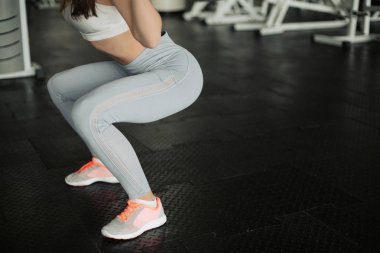
Best Squat Exercises For Glutes (3 Important Exercises)
Best squat exercises for glutes to achieve a firm and sculpted look. Building strong, sculpted glutes is more than just a fitness trend—it’s about enhancing your overall strength, stability, and aesthetics. When it comes to targeting the glutes, few exercises are as effective and versatile as squats. Whether you’re aiming to lift, shape, or tone your backside, the right squat variations can unlock your glutes’ full potential. In this guide, we’ll dive into the best squat exercises that not only fire up your glute muscles but also keep your workouts fresh and challenging. Ready to squat your way to a stronger, more defined lower body? Let’s get started!
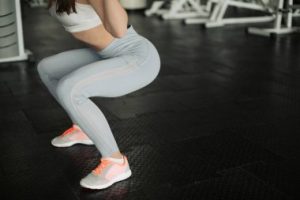
Best Squat Exercises For Glutes
To build strong, toned glutes, the best squat exercises include barbell back squats, sumo squats, Bulgarian split squats, and goblet squats. These movements target the gluteus maximus, medius, and minimus, ensuring balanced development. Incorporating variations and proper form is key to maximizing results.
The Powerhouse Move
Barbell back squats are the cornerstone of any glute-building routine. This exercise engages the entire lower body, but the glutes are the primary focus, especially when you drive through the heels. To optimize glute activation, maintain a deep squat position, where the hips drop below the knees. Keeping the chest up and core engaged not only enhances the workout but also prevents injury.
Targeting the Inner Thighs and Glutes
Sumo squats are another top choice for targeting the glutes, particularly the gluteus medius. The wider stance emphasizes the inner thighs and the outer glutes, making it an excellent variation for those looking to sculpt and tone these areas. The toes should point slightly outward, and as you lower into the squat, focus on pushing the knees out.
Isolation for Glute Growth
Bulgarian split squats are a unilateral exercise that zeroes in on the glutes while also improving balance and stability. By placing one foot behind you on an elevated surface, you create a deeper range of motion that intensifies glute engagement. This exercise is particularly effective for isolating the glutes on each leg, which can correct muscle imbalances.
Versatile and Accessible
Goblet squats are a versatile option for both beginners and advanced lifters. Holding a kettlebell or dumbbell at your chest, you squat deeply, keeping the weight close to your body. This exercise not only targets the glutes but also works the quads and core, making it a well-rounded movement.
Anatomy of the Glutes
The glutes, or gluteal muscles, consist of three key muscles: the gluteus maximus, gluteus medius, and gluteus minimus. The gluteus maximus is the largest muscle in the body and plays a primary role in hip extension and external rotation, making it crucial for movements like climbing stairs and standing from a seated position. The gluteus medius, located on the outer surface of the pelvis, is vital for hip abduction and stabilization, especially during walking or running, as it helps maintain balance. Lastly, the gluteus minimus is the smallest of the three gluteal muscles and assists in hip abduction and internal rotation, contributing to the overall stability and movement of the hip joint.

Benefits of Squat Exercises for Glutes
Muscle Hypertrophy
Squat exercises are highly effective for promoting glute muscle hypertrophy, making them a staple in strength training routine aimed at enhancing glute size and strength. By engaging the gluteus maximus, medius, and minimus, squats target these muscles directly, stimulating growth through repeated tension and overload.
The depth and form of the squat play crucial roles in isolating the glutes, ensuring that they bear the brunt of the workload. Over time, consistent squat training leads to increased muscle fiber recruitment and activation, contributing to greater muscle mass and definition in the glutes. Additionally, variations such as sumo squats or deep squats can further isolate and intensify the activation of the glutes, maximizing hypertrophic benefits.
Strength and Power
Squat exercises are highly effective for building strength and power in the glutes, the largest muscles in the lower body. By engaging the gluteus maximus, medius, and minimus, squats target these muscles intensely, leading to increased muscle mass and strength.
This not only enhances the shape and firmness of the glutes but also contributes to overall lower body strength, crucial for activities like running, jumping, and lifting. Additionally, squats improve explosive power, essential for athletic performance, by promoting fast-twitch muscle fiber activation. This combination of strength and power makes squats a key exercise for anyone looking to improve their lower body fitness.
Improved Functional Movement
Squat exercises are highly beneficial for strengthening and shaping the glutes, which are the largest muscles in the body. By engaging the glutes, squats help improve functional movement, making daily activities such as walking, climbing stairs, and lifting objects easier and more efficient.
This improved strength and mobility not only enhances performance in daily tasks but also translates to better athletic performance in sports, where powerful and stable lower body movements are crucial. Additionally, strong glutes support proper posture and reduce the risk of injuries by stabilizing the pelvis and lower back, contributing to overall functional fitness.
Injury Prevention
Squat exercises are highly beneficial for strengthening the glutes, which play a critical role in injury prevention, particularly for the lower back and knees. Strong glutes help stabilize the pelvis and support proper alignment of the spine, reducing the risk of lower back strain. Additionally, well-developed glute muscles absorb impact and relieve pressure on the knees, which can prevent common injuries such as patellar tendonitis or ACL strains.
Types of Squat Exercises for Glutes
Traditional Squats
Bodyweight Squats
Bodyweight squats are a foundational exercise for building glute strength and can be performed without any equipment, making them accessible for all fitness levels. This exercise primarily targets the gluteus maximus, hamstrings, and quadriceps, while also engaging the core for stability.
To perform a bodyweight squat, stand with feet shoulder-width apart, keeping the chest up and the back straight. Lower your body by bending at the knees and hips, as if sitting back into a chair, until your thighs are parallel to the ground. Push through your heels to return to the starting position. Bodyweight squats can be modified to increase intensity by adding variations such as pulse squats, jump squats, or holding the squat position for longer durations.
Back Squats
Back squats are a foundational exercise for targeting the glutes, emphasizing strength and muscle development. In this exercise, the barbell is placed across the upper back, just below the neck, resting on the trapezius muscles. The stance is typically shoulder-width apart or slightly wider, with toes pointing slightly outward to allow for a natural hip movement.
As you descend into the squat, it’s crucial to lower your hips to at least parallel with the knees, or deeper if flexibility allows, to maximize glute engagement. Maintaining a strong core throughout the movement helps stabilize the body and ensures that the glutes are effectively activated, particularly during the ascent, when you drive through your heels to return to the starting position.
Front Squats
Squat exercises are a fundamental component in building strong and sculpted glutes, and there are various types to target different muscles. Front squats are particularly effective for glute development while also engaging the quadriceps and core more intensely than other variations. The key difference in front squats lies in the barbell placement; it is positioned across the front of the shoulders rather than on the back, as in traditional back squats.
This forward placement shifts the center of gravity, requiring greater core stabilization to maintain an upright posture. Additionally, front squats emphasize the quadriceps, making them an excellent compound exercise for lower body strength while still engaging the glutes effectively.

Variations of Squats Targeting Glutes
Sumo Squats
Sumo squats are an excellent variation of traditional squats that focus more on the glutes and inner thighs. By adopting a wider stance with your toes pointed outward, you target the gluteus maximus and the adductor muscles more effectively. This stance allows for a deeper squat, which increases muscle engagement in the lower body, particularly in the glutes and inner thighs. Sumo squats are beneficial for those looking to enhance their glute development and improve lower body strength and stability. Incorporating them into your routine can lead to better overall glute activation and muscle tone.

Bulgarian Split Squats
Bulgarian split squats are an effective exercise for targeting the glutes, emphasizing single-leg strength and stability. To perform this exercise, stand a few feet in front of a bench or elevated surface, then place one foot behind you on the bench. Lower your body by bending the front knee until your thigh is parallel to the ground, keeping your torso upright. This rear foot elevation shifts the focus to the glutes and hamstrings of the working leg, promoting greater muscle activation and strength development in these areas. Bulgarian split squats are particularly beneficial for improving balance, enhancing unilateral strength, and building overall lower body power.
Pistol Squats
Pistol squats are a challenging single-leg exercise that significantly enhances glute engagement and overall leg strength. In this movement, you balance on one leg while lowering your body into a deep squat position, extending the other leg forward. This demanding exercise not only targets the glutes but also improves balance and stability. By performing pistol squats with just your bodyweight, you effectively maximize glute activation, leading to greater muscle development and functional strength. Mastering this exercise can lead to improved performance in other activities and contribute to a more balanced lower body.
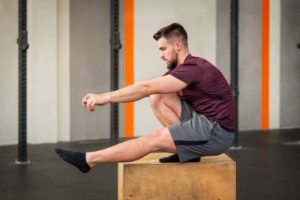
Box Squats
Box squats are a powerful variation of the traditional squat that focus on controlled movement and glute activation. By squatting down to a box or bench, you create a consistent depth for each repetition, which helps to standardize the exercise and ensures proper form.
The controlled descent to the box emphasizes muscle engagement, particularly in the glutes and hamstrings, as you maintain tension and avoid letting gravity take over. At the bottom position, briefly pausing before pushing back up helps to reinforce the engagement of the glutes and enhances the drive through the ascent, making it a highly effective exercise for strengthening and developing the posterior chain.
Goblet Squats
Goblet squats are a highly effective exercise for strengthening the lower body and improving flexibility. To perform a goblet squat, hold a kettlebell or dumbbell close to your chest with both hands, keeping your elbows pointed down and your shoulders relaxed. This position encourages an upright torso, which helps maintain proper posture throughout the movement.
As you lower yourself into a squat, aim to descend until your thighs are parallel to the ground or lower, ensuring your knees track over your toes and your chest remains lifted. The goblet squat emphasizes a deep squat position, promoting better hip and ankle mobility while also targeting the quads, glutes, and core.
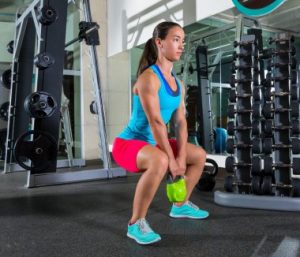
Advanced Squat Techniques
Pause Squats
Pause squats involve holding the squat position at the bottom of the movement, typically for a few seconds before rising. This technique increases the time under tension for the muscles, particularly targeting the glutes and quads. By pausing, you eliminate momentum and force the muscles to work harder to maintain stability and generate power. This increased time under tension can enhance muscle activation and promote greater strength and hypertrophy in the glutes, making pause squats an effective exercise for developing lower body strength and muscle definition.
Banded Squats
Banded squats are an effective exercise for targeting the glute medius and enhancing lower body strength. By placing a resistance band around the knees, you create added tension that promotes greater activation of the glute medius during the squat movement. As you perform the squat, the band encourages proper knee alignment and engages the muscles of the hips and glutes more intensely.
This not only helps in developing a stronger, more stable lower body but also improves overall balance and functional movement patterns. Incorporating banded squats into your workout routine can be particularly beneficial for addressing muscle imbalances and enhancing athletic performance.
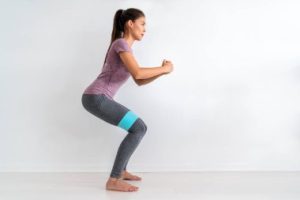
Squat Jumps
Squat jumps, when combined with a plyometric component, are a powerful exercise for enhancing explosive power and glute engagement. This dynamic move begins with a standard squat, where you lower your body by bending at the hips and knees. As you push through your heels to rise, you then explosively jump off the ground, aiming to reach maximum height.
The plyometric nature of this exercise challenges your fast-twitch muscle fibers, leading to greater strength and power gains. Additionally, the explosive movement engages the glutes intensely, promoting muscle growth and improving overall lower-body strength. Regular incorporation of squat jumps into your routine can effectively boost athletic performance and enhance functional strength.
Common Mistakes and How to Avoid Them
Improper Form
One common mistake in performing squats to target the glutes is improper form, which can lead to reduced effectiveness and potential injury. A frequent issue is allowing the knees to cave inward during the squat, which places undue stress on the joints and diminishes the engagement of the glute muscles.
To avoid this, focus on maintaining a neutral spine, keeping your chest up, and pushing your knees outward in line with your toes as you descend. Another mistake is leaning too far forward, which shifts the emphasis away from the glutes and onto the lower back. To correct this, ensure that your weight is distributed evenly across your feet, with your hips moving back as if sitting in a chair. Engaging your core throughout the movement can also help maintain proper alignment and maximize glute activation.
Neglecting Warm-Up
One common mistake in performing the best squat exercises for glutes is neglecting a proper warm-up. Failing to activate the glutes and enhance hip mobility can undermine the effectiveness of the exercise and increase the risk of injury. To avoid this, start with dynamic stretches and activation drills that specifically target the glutes and hips.
Exercises like hip bridges, leg swings, and bodyweight squats can help prepare these muscles for the demands of heavier squatting. Ensuring that your muscles are properly warmed up and activated will not only improve your squat performance but also help you achieve better results in strengthening your glutes.
Overtraining
One common mistake in performing the best squat exercises for glutes is overtraining, which can lead to diminished results and potential injury. To avoid this, it’s crucial to balance intensity with adequate recovery. Overtraining occurs when you push your muscles too hard without allowing enough time for them to recover and repair. This can result in fatigue, decreased performance, and increased risk of injury.
To prevent overtraining, ensure you include rest days in your workout routine and vary the intensity of your squats. Incorporating exercises that target different muscle groups, alongside proper nutrition and hydration, will help optimize muscle growth and overall performance while minimizing the risk of overuse injuries.
Ignoring Glute Activation
One common mistake in performing squats for glute activation is failing to engage the glutes throughout the entire movement. To ensure the glutes are effectively targeted, start by consciously squeezing them before you even begin the squat. As you descend, keep your hips pushed back and your core tight, maintaining a straight back and ensuring your knees don’t extend past your toes.
At the bottom of the squat, pause briefly to fully activate the glutes before driving back up through your heels. To maximize glute engagement, consider incorporating variations like sumo squats or Bulgarian split squats, and use resistance bands around the knees to reinforce proper activation and technique. Regularly check your form in a mirror or with a trainer to ensure you’re effectively targeting the glutes and not relying too heavily on other muscle groups.
FAQs on the Best Squat Exercises for Glutes
Q1. What are the most effective squat variations for targeting the glutes?
Answer: Some of the most effective squat variations for targeting the glutes include the Bulgarian split squat, sumo squat, and deep squat. These exercises engage the gluteal muscles more intensively due to the range of motion and stance, making them highly effective for glute development.
Q2. How does the depth of the squat influence glute activation?
Answer: The depth of the squat plays a significant role in glute activation. Deeper squats engage the glutes more effectively as they require the gluteal muscles to work harder to extend the hips and return to the starting position. Aim to squat at least parallel to the ground or lower to maximize glute engagement.
Q3. Should I add weights to my squat routine to build bigger glutes?
Answer: Yes, adding weights to your squat routine can significantly enhance glute development. Weighted squats, such as barbell squats or goblet squats, increase resistance, leading to greater muscle stimulation and growth. Start with a weight that challenges you while maintaining proper form.
Q4. How often should I perform squat exercises to see noticeable glute gains?
Answer: For noticeable glute gains, aim to incorporate squat exercises into your workout routine 2-3 times per week. Consistency, combined with progressive overload (gradually increasing the weight or intensity), is key to seeing results. Make sure to allow adequate rest and recovery between sessions.
Q5. Can squats alone give me well-rounded glutes, or should I incorporate other exercises?
Answer: While squats are excellent for glute development, they should be part of a balanced lower-body routine. To achieve well-rounded glutes, incorporate other exercises such as hip thrusts, lunges, and deadlifts, which target different parts of the gluteal muscles and enhance overall muscle symmetry.
Q6. Is it normal to feel more soreness in my thighs than in my glutes after squats?
Answer: It’s not uncommon to feel soreness in your thighs, particularly the quadriceps, after squats. However, if you’re aiming to target your glutes more, you may need to adjust your form or try different squat variations. Focus on pushing through your heels and keeping your knees in line with your toes to better engage the glutes.
Q7. Are bodyweight squats effective for glute growth, or do I need to use weights?
Answer: Bodyweight squats can be effective, especially for beginners, but for more substantial glute growth, incorporating weights is recommended. Progressive overload, which involves gradually increasing the resistance, is crucial for muscle development. Adding weights will help challenge the glutes more and lead to greater muscle growth.
Q8. How can I prevent my lower back from hurting during squats?
Answer: To prevent lower back pain during squats, ensure that you maintain a neutral spine and engage your core throughout the movement. Avoid rounding or excessively arching your back. Additionally, work on your flexibility and mobility, particularly in the hips and ankles, to achieve proper squat form.
Q9. What’s the difference between a sumo squat and a traditional squat in terms of glute activation?
Answer: The sumo squat, characterized by a wider stance with toes pointing outward, targets the glutes and inner thighs more than a traditional squat. The wider stance of the sumo squat places more emphasis on the gluteus medius and minimus, making it an excellent variation for comprehensive glute development.
Q10. Can squats help lift and tone the glutes, or are other exercises needed?
Answer: Squats are highly effective for lifting and toning the glutes due to their ability to engage multiple muscle groups, including the glutes. However, for optimal results, it’s beneficial to combine squats with other glute-specific exercises like hip thrusts and glute bridges, which further isolate and target the gluteal muscles.
Conclusion
In conclusion, the best squat exercises for glutes include a mix of traditional squats, sumo squats, Bulgarian split squats, and hip thrusts. Each of these exercises targets the gluteal muscles from different angles, ensuring comprehensive development and strength. Incorporating variations such as adding resistance bands or weights can further enhance muscle activation. To maximize results, it’s important to maintain proper form, progressively increase intensity, and combine these exercises with a well-rounded fitness routine. Consistent practice of these squat variations will lead to stronger, more defined glutes over time.